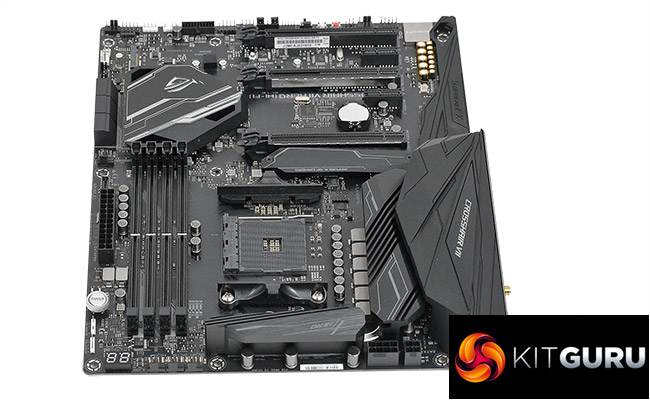Asus ROG Crosshair VII Hero Wi-Fi is an impressive motherboard in every sense of the word.
It looks superb in that ROG-gy way, uses top line components and has a long list of features. While it is fair to say that you will find extra features on more expensive ROG boards we cannot criticise Asus for any aspect of the hardware on the ROG Crosshair VII Hero Wi-Fi as it is fits the brief to perfection. Overclockers will appreciate the plethora of micro buttons, yet there is also plenty to appeal to the mainstream enthusiast.
You get a huge number of fan headers that help when you install the motherboard in a case, and you also get massive number of USB ports on the I/O panel that transform the Asus into a very practical proposition. Positioned around the board you will find a selection of RGB headers that even allow you to connect the Aura lighting to Philips Hue. On the one hand this motherboard can handle some serious overclocking while on the other it can also accommodate more prosaic stuff such as printers and card readers.
If the list of options in the Extreme Tweaker section of the UEFI doesn’t make you sit up and pay attention we can only feel sorry as you clearly lack appreciation for the finer things in life.
Using the 8601 BIOS highlighted a fundamental conflict between ROG and 2nd Gen. Ryzen which goes like this:
ROG is aimed at overclockers who want manual control of every last voltage setting and clock speed. The external clock generator chip used by Asus demonstrates this point as you can use the motherboard either in Synchronous or Asynchronous mode. In Synchronous mode the CPU shares the clock signal with Memory and PCIe while in Asynchronous mode those buses are locked down and the CPU clock can be adjusted independently.
Clearly the external clock generator feature is aimed at overclockers who want to work on the BCLK without causing other problems which is a sport of minority interest. That is entirely in tune with the ROG ethos as only the hardcore enthusiasts need to apply for membership.

Where things go off the rails is on the AMD side of things. 2nd Gen. Ryzen has a fair amount in common with the original Ryzen however AMD has worked hard on Precision Boost 2 and XFR 2. These features dynamically overclock your CPU, provided you have sufficient power and cooling, and between them they extract most of the performance your new Ryzen has to offer.
Asus demonstrates this point, perhaps unwittingly, with the Auto settings in 8601 that deliver excellent performance out of the box with zero input from the user. The downside is that this configuration draws 40W or 50W more than you expect to see compared to an ASRock X470 Taichi or Gigabyte X470 Aorus Gaming 7 on stock clocks, and the CPU temperature is about ten degrees C higher. Those are very large numbers and they show the Asus in a poor light.
When it comes to overclocking with the ROG Crosshair VII Hero Wi-Fi you can raise the clock speeds in the usual way and set the voltages any way you choose. We dialled in settings of 1.4V and a 42.5 multiplier and something rather curious happened. CPU clock speed was rock solid at 4.25GHz, however performance changed very slightly, to a much smaller extent than you would expect for an extra 200MHz. Balanced against that we saw the CPU temperature drop five to ten degrees below Auto settings and power draw was down about 10W.
In other words, if you leave the Asus ROG Crosshair VII Hero Wi-Fi on Auto you get good performance with awful thermals and power draw but if you do a basic manual overclock the board falls into line with comparable motherboards from the other vendors.
We are quite sure this behaviour is inherent to the nature of 2nd Gen. Ryzen and does not reflect on Asus ROG in any way. They have delivered a motherboard that is truly epic and it is simply running into the limits of the CPU. It would seem that dynamic overclocking has arrived and manual overclocking is on the wane.
You can buy the motherboard from Overclockers UK for £259.99 HERE.
Pros:
- High quality hardware, excellent VRMs.
- Extensive UEFI set-up screen.
- Loads of overclocking feature and micro buttons.
- I/O panel is packed with USB ports.
Cons:
- Power draw on Auto settings is high.
- The Asus is let down by the limited headroom you get with 2nd Gen. Ryzen 7.
- Price is fairly steep.
- When you manually overclock performance is similar to other motherboards.
KitGuru says: Asus ROG Crosshair VII struggles to extract more performance from Ryzen 7 2700X.
Be sure to check out our sponsors store EKWB here
 KitGuru KitGuru.net – Tech News | Hardware News | Hardware Reviews | IOS | Mobile | Gaming | Graphics Cards
KitGuru KitGuru.net – Tech News | Hardware News | Hardware Reviews | IOS | Mobile | Gaming | Graphics Cards




